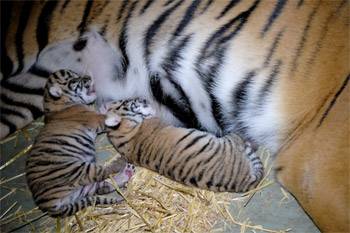Two Tiger Cubs at Australia Zoo

Two Tiger Cubs at Australia Zoo
On Monday, Australia Zoo's tiger team were thrilled to discover that one of our critically endangered Sumatran tigers, Kaitlyn, had safely delivered her second litter of beautiful cubs. Australia Zoo are proud to announce that brothers Hunter and Clarence born to Kaitlyn in 2013, are now joined by a half-brother and half-sister!
Going into labour at 11:30am on Saturday morning, Kaitlyn delivered her daughter first at 1pm and her new son on Monday at 9:45am. Like Hunter and Clarence, these cubs carry significant genetic value in the captive breeding program for Sumatran tigers because of Kaitlyn's wild bloodline.
Giles Clark, Head of Australia Zoo's Tiger department, has confirmed that both Kaitlyn and her two new cubs are healthy and doing well.
'We're so thrilled about Kaitlyn's brand new cubs! They signify an important milestone by continuing the wild bloodline of Sumatran tigers in the global breeding program.
At the moment there are less than 500 Sumatran tigers left in the wild which means there's a very real possibility that this incredible species could become extinct in our lifetime. Cubs like these are the insurance protecting tigers from disappearing altogether," said Giles.
The new cubs will play an important role acting as ambassadors for their wild cousins and raising much needed awareness and funds to protect tigers in Sumatran jungles from illegal poaching and habitat destruction.
Tigers are listed as critically endangered, but it takes just $5 to save a tiger in the wild for one day. Over the past decade, visitors to the Zoo have helped raise over $1.3 million to support our tiger conservation project in Sumatra making our program the most successful in the world.
Just like with Hunter and Clarence, the new cubs will become part of our tiger program bonding with our keepers from an early age. This bond between the cubs and their keepers will allow the Tiger Crew to give them the best possible quality of life at the Zoo including enrichment through various different experiences and interactions.
Visitors to Australia Zoo will have the opportunity to see the cubs for the first time in late March.
Photo credit: Giles Clark / Australia Zoo
MORE





